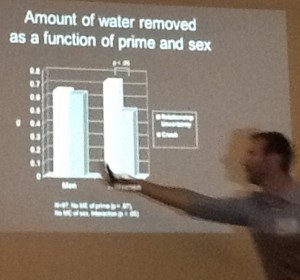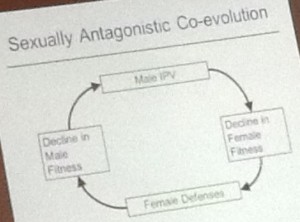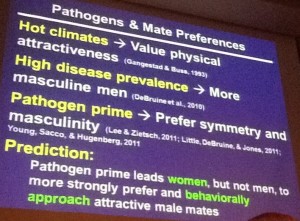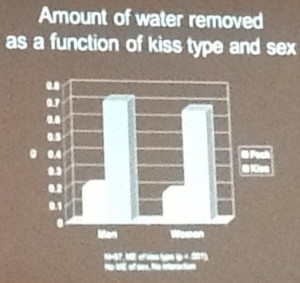The highlight of Saturday’s talks was my slowly growing consciousness of this new theoretical paradigm called the “behavioral immune system” that I’ve written about in the past & will write about again in the future but the scope (& name) of which I’d been ignorant. But the first session I went to though focused on several lines of study I found myself talking to a woman in the airport about & have been talking up to several of my students since I got back.
A woman who sat down next to me as we were waiting for American Airlines to totally botch up everyone’s flights home was asking me whether the iPad is all that useful as she was reading a book by Paul Ekman. Turns out she’s a counselor who works with victims & perpetrators of domestic & sexual violence who wants to learn how to “read” them, ala Tim Roth in Lie to Me. The conversation reminded me of the talk by Cari Goetz from David Buss’s evo psy lab about “Sexual exploitability: Observable cues & their link to sexual attraction.” These cues she framed as exploitative resource acquisition strategies of males to deceive, coerce & force females for short-term sexual access. After reliability testing, Goetz identified 63 initial cues associated with such exploitation that could be categorized as psychological, incapacitation-related, or physical. Psychological cues indicate a female may be mentally or emotionally manipulable (e.g., low intelligence, immaturity, low assertiveness), flirtatious, promiscuous, or engage in risky behavior. Cues of incapacitation regard drunkeness or fatique, while physical cues relate to being physical able to restrain (e.g., short, small, slow). Among those positively correlated with exploitability were “easy,” “immature,” “drunk,” “reckless,” “flirty,” “partying,” & “sleepy,” while negatively correlated cues included “intelligent,” “age,” “anxious,” & “passed out.” I think it’s important to avoid a “blame the victim” interpretation of such information. Not all guys are looking to exploit thru coercion, but, let’s face it, guys (& girls) are not averse to seeking out easy lays & under the best of circumstances, such interfaces can get a little dicey. It’s important for those who don’t want to be exploited to be self-aware & recognize (1) they might be putting out cues they don’t intend to & (2) there are assholes out there looking for these very cues & have every intention of exploiting them, so be careful. That said, I found the photos Goetz used obvious & suggested some cues are subtle enough to show up in even neutral photos.
A.J. Figueredo gave a talk on “fast” & “slow” life history strategies, a theoretical approach to behavior that an adjacent poster presenter had just turned me on to the night before. Figueredo has also linked the slow life history strategy (sorta like a normal workaday life) with a “mutualistic” sexual schema, or tending to form bonds or partnerships & mutually raise families (dad?), & the fast strategy (like life in the fast lane?) with an “antagonistic” sexual schema, or a promiscuous & distrustful of commitment approach (cad?). The slow life history strategy inhibits negative thinking & sociopathy, Figueredo suggests, while the fast strategy facilitates it, statistically contributing strongly to intimate partner violence.
Aaron Goetz gave a fascinating talk on kissing petri dishes. With tongue. Just kidding. No, Goetz has tested an alternate to the several hypotheses of kissing, focusing on kissing as a costly honest signal of commitment. Kissing is a big deal across most cultures, being evidenced in 90%+ of cultures worldwide as recognizable lip-locking & in most of the rest as something similar. The Kama Sutra has several whole chapters devoted to kissing. As Goetz suggests, an alien anthropologist visiting our planet would probably figure out the penis-in-vagina-helps-species-reproduce thing pretty quick but would be left puzzling over (& thus especially interested in) the exotica of the odd lip-touching thing. Previous models have suggested variously that kissing is a mechanism for dental hygiene (which, Goetz pointed out, means we should seek to kiss disproportionately when we have spinach between our teeth to get it sucked out–um, no, I don’t think so), an important sexual priming mechanism (foreplay), a pair-bonding (oxytocin) mechanism, a maternal mastication by-product (?!), or, as posed by fellow Gallup alums Susan Hughes, Marissa Harrison & one of my grad advisers Gordon Gallup, is a test of mate quality (which I still hold is not mutually exclusive of Goetz’s model). But kissing is costly, as it exposes the kisser to a host of diseases (Paul Ewald gave an ALLELE talk on this a while back & had us thinking about the lack of kissing among the Canela, in an area where pathogen load is high…part of the behavioral immune system?…but how to explain all the screwing…). Thus, a huge perceptual shift takes place when one partner becomes less interested with regard to kissing–that partner begins kissing less, but the other partner begins kissing more.
To test this correlation, Goetz et al. designed an ingenious test. They placed a petri dish with a thin layer of water in it on a scale & asked participants to alternately touch it with their lips & to kiss the dish (they left the room to give them privacy with their “dish”). They found that, relative to the lip-touching condition, males & females sucked up water when they kissed the dish. Next they primed participants with relationship uncertainty & found that females but not males suck up even more water when they are concerned about the status of their relationship (I’m having flashbacks here–I remember pretending to be asleep until I had to go to work so I could stop kissing a girl & make a final getaway & her hovering over me like a hawk ready to dive back in if my eyes opened…frightening really).

Females will suck the brains right out of your head rather than let you get away–kidding, females suck up more water when primed with relationship uncertainty (Aaron Goetz)
Next up, as a simplifying heuristic (I know that’s redundant), David Buss described resource acquisition strategies that can be individual, cooperative, & exploitative. For instance, when a male experiences a decline in fitness, he may resort to intimate partner violence (IPV) to retain his fitness (exploitation), which results in a decline in the female’s fitness. She enlists defenses that further undermine his fitness, in a negative feedback loop. Male IPV can take the form of mate poaching, which is a universal strategy. In the classic formulation, a male friend drives a wedge between his female acquaintenance & another guy telling her he is no good for her & insinuates himself as the replacement. Other lines of evidence have found that male violence toward pregnant women suspected of infidelity is directed toward their abdomens more than faces or other areas of their bodies. These unfortunate aspects of relationships are what Buss terms “relationship load,” the hidden costs found deep in relationships, indicating mate value discrepancies with the package as originally advertised & purchased.  Buss highlights the role of self-deceptive diminishment in such contexts, in which women finds ways to rectify themselves to the situation, as it’s difficult to get out. Self-deception goes both ways. On the one hand, most professors think they’re better instructors than their colleagues (Lake Wobegon effect) (they’re reading my mind!); on the other hand, 69% of battered women return to their batterers for one reason or another, deceiving themselves into thinking it’s the right thing to do. Stalking is another form of IPV, but it is difficult to study because stalkers don’t define their stalkers as stalking (Buss asks for a show of hands of stalkers to be recruited for research). Stalking works as mate guarding because the inclination is to steer clear of a female who has a stalker (“get rid of your stalker, then we’ll date”). Ultimately, IPV is effective because it exploits what are otherwise female adaptations (e.g., anti-injury/homicide or child-protection adaptations).
Buss highlights the role of self-deceptive diminishment in such contexts, in which women finds ways to rectify themselves to the situation, as it’s difficult to get out. Self-deception goes both ways. On the one hand, most professors think they’re better instructors than their colleagues (Lake Wobegon effect) (they’re reading my mind!); on the other hand, 69% of battered women return to their batterers for one reason or another, deceiving themselves into thinking it’s the right thing to do. Stalking is another form of IPV, but it is difficult to study because stalkers don’t define their stalkers as stalking (Buss asks for a show of hands of stalkers to be recruited for research). Stalking works as mate guarding because the inclination is to steer clear of a female who has a stalker (“get rid of your stalker, then we’ll date”). Ultimately, IPV is effective because it exploits what are otherwise female adaptations (e.g., anti-injury/homicide or child-protection adaptations). While IPV works for the offender, to suggest that it is appropriate because it can be explained using evolutionary theory is an example of naturalistic fallacy (& David Buss won’t testify in your defense when you get arrested!).
While IPV works for the offender, to suggest that it is appropriate because it can be explained using evolutionary theory is an example of naturalistic fallacy (& David Buss won’t testify in your defense when you get arrested!).
At 3PM I popped into an evolutionary medicine session for one talk (not sure why I didn’t stay for more) to hear S.G. Brown talk about their use of salivary immunoglobulin A in measuring immune response to a disgust prime. Since we are using SIgA in study we are doing, I was curious to hear of its utility in this behavioral immune system paradigm study. Though numerous studies over the past several years have picked up on this, the poster presenter next to me on Friday night was the first I had heard of using a “disgust prime.” In his study, he primed subjects by showing them photos of disgusting things then collected a set of vocal attractiveness ratings & found that the disgust prime made the higher testosterone voices even more attractive than usual. In Brown & colleagues study, they measured SIgA in people with “collectivist” versus “individualist” heritages after priming them for disgust. Collectivist cultures are those that emphasize the collective over the individual, tend to be located at lower latitudes, be more conservative, & share other features associated with pathogen-aversion consistent with the behavioral immune system model. Individualist cultures are those that emphasize individual over the collective, tend to be located at higher latitutdes, & be more liberal & diverse. In both the prime & a neutral condition, participants from collectivist backgrounds (they study was conducted in Hawaii, so they have a lot of students with Polynesian collectivist heritages) had non-significantly higher SIgA levels than those from individualist backgrounds. Given small samples sizes & the great variability seen in salivary biomarkers, this is grounds for further investigation.

Stephanie Cantu: When are women especially attracted to attractive men? Adaptive mating psychology in a pathogen-prevalent ecology
Later there was a whole session on this same behavioral immune system that I caught part of. A second talk by Stephanie Cantu related to “Adaptive mating psychology in a pathogen-prevalent ecology.” The prediction tested in their experimental study was that a pathogen prime would lead women to prefer attractive mates more than in the absence of pathogenic stimulation & to approach them more. I believe they found tentative support for these hypotheses, but I did not tweet the results. According to my tweet-notes, I seem to have gotten distracted pondering if self-deception re preference for attractiveness go up when primed for disgust…The following talk I did not take many notes on, but the subtitle says it all: “Relatively unattractive faces appear especially unattractive to individuals higher in pathogen disgust.” Josh Tybur gave a theoretical talk on this subject, pointing out the extent to which this paradigm is filtering into pop culture–apparently in L.A., they actually have speed dating where you sniff worn t-shirts ala the now-class MHC compatibility “smelly t-shirt” experiment & pick the guy to go out with based on which has the best smell (I hope they only do this when they’re ovulating–didn’t one study find women like familiar smells when they’re not ovulating?).

You know about the major histocompatibility complex (MHC) heterozygosity preference, but there are the benefits you are selecting for (Josh Tybur)
I skipped the banquet & went across the street to my fave new restaurant in Albuquerque. I’m so jealous. Right across the street from the UNM campus they have the Frontier Restaurant, which is open about 20 hrs/day, 7 days/wk. They have great southwestern food, in addition to the usual diner hamburgers & such. And it’s dirt cheap. You order at the counter, so there’s no tipping. Great for students. Local. Affordable. Incredibly filling. I tried the green chile stew, the pozole, the fiesta burger with green chile sauce, the enchiladas, the adovada burrito, the breakfast burrito with adovada, the tortilla soup, the sweet buns…I think I ate elsewhere once in 4 1/2 days. 
Anyway, I was so happy I skipped the banquet because I stumbled on Bruce Potts, who has full facial tattoos in Samoan style. Since we’ve been engaged in a study of immune stability with regard to tattooing, I had to talk to him. He told me that he didn’t know about immune response but that tattooing actually hurts more as you get older & that he’s done! His legs weren’t as covered as his face, but he said no more. I took a really crappy photo with my camera & regret not pulling the iPad out to get a photo with him. But he was kind enough to acquiesce & chat with me. He was interested in the conference & asked about us. He’s actually an adjunct lecturer at the UNM & I asked him if his extensive tattooing is a distraction to students.
He claims facial tattoos are so common in big cities now that people don’t notice so much. I sat behind him after this & watched people watch him & EVERYONE stole glances. A little self-deception me do thinks. I pointed out that I’d lived in NYC for 18 years & never saw someone’s head that tattooed there (I arrived right around the time or right after Tattoo Mike died). I saw crusty kids & punks & such with lots of facial tats–don’t get me wrong. Well, just look at the picture. How often do you see that, even given the ubiquity of tattoos nowadays? But I’m not trying to make a spectacle of it. He fascinated me & I’m so glad I missed the banquet to meet him. I would have stayed longer talking, but I was afraid of missing the keynote too.
Paul Bloom is a behavioral neuroscientist & cognitive & developmental psychologist from Yale. His keynote was simply the most natural & engaging delivery I have seen at a conference ever. I believe it was a usual hour-long talk that passed in what seemed like 5 minutes as I sat in a chair along the wall while the banqueters kept eating. His talk was “But is it Art?: A Case Study in the Cognitive Science of Pleasure” & the focus was on what it is about art that we like, what gives us pleasure. Bloom made the statement that the root of art is in essentialism & that it is the same pleasure in terms of cognitive mechanisms that we get from pornography. People enjoy looking at attractive naked people, but you can’t always have an attractive naked person around when you want one. So what makes art different from pornography? Bloom says it is the history we associate with art. For instance, the infamous Nazi Gehring was an art afficionado & competed with Hitler in looting, annihilating, & buying to bolster his collection. It is said, perhaps apocryphally (but who cares), that Gehring discovered for the first time there was evil in the world when he was told his most precious possession, a Vermeer that he had scoured Europe & ultimately paid thru the nose for, was a forgery. He is another example–say you really like a hot girl or guy. Will finding out he is not really a he or she is not really a she change how hot you find him/her? It will, won’t it? This is what it’s like to find out great art is forged, even though it still took great talent & much work to make a forgery that fools almost everyone. What about great art makes it great? What if you had the opportunity to buy George Clooney’s sweater? I believe such things can go for a considerable amount on eBay. But his sweater’s value goes down if there is a stipulation that you are not allowed to resell it, not allowed to tell anyone you’ve bought it, or if you find out it’s been washed since he last wore it. So there’s something about the provenance & the social context that gives art (or a dirty sweater) value. The famous violinist Joshua Bell, who makes millions to play at (Carnegie Hall? Lincoln Center? somewhere I can’t afford to go) was asked to participate in an experiment in which he played anonymously in a subway for 45 minutes. He only made $38 & $20 of that came from the lone person who indicated she recognized him & felt badly he’d ‘fallen so far.’ As another example, you can buy John Cage’s classic avante guard piece “4’33” on iTunes for $1.99, which, for those who don’t know, is 4 minutes & 33 seconds of John Cage sitting silently at the piano. For $1.99, you can buy the history of THAT silence. But it’s also more than history. Pleasure in arts & sports is the appreciation of the capacities of these individuals, of their great talent, work, ability to perform under pressure, etc. Believing in the importance of something changes the experience of it of course. Because you love your husband very much, you don’t think he looks like a toad–liking influences deception. Because of the time & talent necessary to forge representational art, it is more outrageous to forge Duchamp’s toilet, which took genius to conceive of but not to execute.
Next, I peter out on the last day with everyone else but enjoy the most useful session for my own work going forward & meet one of the rock stars of the field…





Pingback: HBES 2012 Roundup 4: Father’s Day & the Parasite-Driven Wedge | Welcome to the EvoS Consortium!
Pingback: HBES 2012 Roundup 1: Joint Day with the Animal Behavior Society | Welcome to the EvoS Consortium!
Pingback: HBES Roundup 2: Brian Hare’s Chimp/Bonobo Cognition Plenary, Mommy Brain Fogs, & Baba Brinkman Evolution Raps | Welcome to the EvoS Consortium!